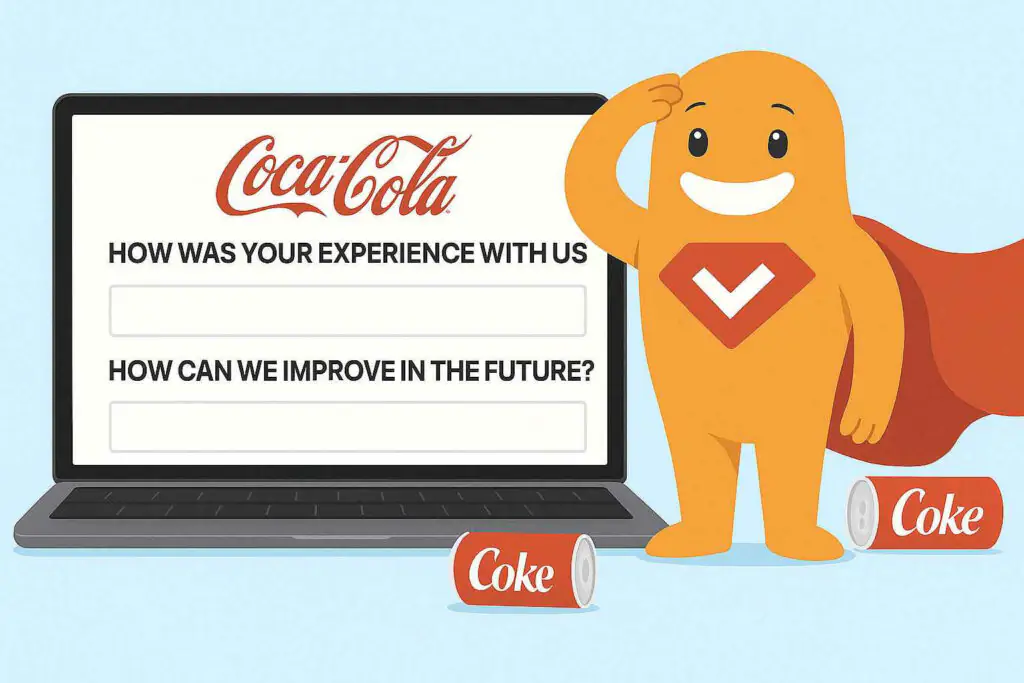Think of a brand. Now, think about what you associate with that brand. Most likely, you chose a brand based on your personal experiences with it. Or, you may have chosen a brand that you’re familiar with, such as Apple, Nike, McDonald’s, or Starbucks, even if you don’t use these brand’s products or frequent their establishments. That’s okay; you probably have thoughts about them based on their pop culture relevance alone.
Your interactions and perceptions of the brand you chose are what is known as “brand image.” Some companies may struggle to develop a brand image, while others are quite successful at it. One of the ways companies begin to establish a brand image is by creating a brand identity.
Create your brand identity survey, form, or poll now!
What Is Brand Identity?
A brand identity consists of the elements used by a company to create that all-important brand image. Brand identity typically stems from a company’s mission, value proposition, long-term goals, competitive position, and their relevance to the values and interests of its target audience. The most common elements of brand identity include:
- Brand name
- Logo and wordmark
- Taglines or slogans
- Colors and graphic styles
- A style and typeface
- A voice and tone
All of these elements work together to communicate to consumers who the company is and what it stands for.
The Importance of Creating a Brand Identity
A consistent and cohesive brand identity is part of any successful branding strategy. A lot of thought should go into brand identity, and once it has been developed, it needs to be maintained. Deviations from brand identity, especially once it is well-established, need to be carefully considered as that could impact brand image. So With that said, here are five reasons why brand identity is important.
- Personality. Brand identity is the visual representation of your “personality”; it often evokes a specific feeling in your audience and sets the tone for what they can expect from you.
- Consistency. Developing a brand identity with specific styles and design elements helps you to be consistent across all forms of media, so your audience recognizes you whether you’re advertising on a billboard or sending them an email.
- Differentiation. Your brand identity sets you apart from competitors in your realm. While you may want to mimic some aspects of their identity to fit in, you’ll also want to do your own thing to stand out.
- Awareness. Simply put, the more your brand is seen, the more memorable it will become. Read more about building brand awareness.
- Loyalty. An effective brand identity gains the trust of consumers over time. When this happens, they’re more likely to make return visits and purchases, and possibly recommend your brand to others, becoming “brand advocates.”
15 Questions to Ask Yourself When Creating a Brand Identity
Creating a brand identity should begin with some self-reflection. You’ll want to ask yourself the following questions:
- Who are my customers? Who do I want my customers to be?
- How do you want to speak to customers? What do they want to hear?
- What problems do my products/services solve for my customers?
- What is my brand’s personality? Fun? Serious? Refined? Outspoken?
- Who are my competitors? How am I like them? How am I different from them?
- What feelings should my brand inspire in my audience? What feelings should it not inspire?
- What is my brand’s story? How was it formed? What struggles were overcome to get here?
- Which brands speak to me? What brands would I like to emulate?
- What colors represent my brand? What image represents my story?
Now, let’s get a little more abstract. Use your imagination and creativity when asking yourself the following questions, which can really help nail down a brand identity:
- What kind of clothing does your brand wear?
- Where would your brand hang out?
- What actor or actress would play your brand?
- What kind of music does your brand listen to?
- What type of car does your brand drive?
- What animal would your brand be?
By asking yourself these questions, you can have an idea of who you want your brand to be before soliciting input from the public.
Creating a Brand Identity with Surveys
It’s always a good idea to get input from the public to see if their perceptions of your brand identity match up with your intentions. Now that you’ve completed the exercises above, you’re ready to put yourself out there and get some feedback with a brand identity survey!
If you’ve already created your brand identity elements, it may simply be a matter of placing them into a survey format and asking respondents what they think. You may consider the following type of questions:
- Open-ended questions, which give participants a lot of freedom to provide input.
- Multiple choice questions, which keep participants focused but give them some options (this is ideal when you ask them to describe your brand using adjectives; check out some brand adjectives you may want to supply as potential answers here).
- Likert scale questions, which allow participants to answer on a Likert scale such as 1-10 or Excellent to Poor.
Often, branding surveys will use several types of questions depending on the kinds of answers the survey-maker seeks.
After you’ve presented all your brand image elements for consumer survey feedback, another way to see whether you’re on the same page with your audience is to ask those same abstract questions identified earlier as brand identity survey questions. Why? Well, if you see your brand driving a Porsche and your customers see it behind the wheel of a Pinto, or you think it listens to Miles Davis but your customers see it twerking to Miley Cyrus, there’s a disconnect that needs to be repaired. Some of these questions may also be suitable when determining branding questions for clients as well.
Are you still in the development stages of your brand identity? Then you may want to present your survey participants with multiple logos, fonts, and messages to see which they prefer. In this case, you will want to consider picture-based surveys that allow participants to select their favorites based on visuals. You can also use this type of survey to pit it against your competition to see how it appears to stack up.
Conclusion
Creating a brand identity isn’t always easy, but online surveys are one of the most effective methods to help guide your direction. By asking the right brand identity survey questions you can gain an understanding of what consumers think of your brand, and ways they think you may be able to improve it.
At SurveyLegend, we offer a variety of types and styles of surveys, perfect for creating your brand identity survey. You can check out some of our survey examples and templates now, or get started creating a brand identity survey now for free.
Have you used a brand identity survey in the past? What insights did it give your leadership or brand marketing team? Let us know in the comments!
Create your brand identity survey, form, or poll now!
Frequently Asked Questions (FAQs)
Brand identity consists of the elements used by a company to create a brand image.
Brand identity consists of a brand name, logo and wordmark, taglines and slogans, colors and graphics, typeface, voice and tone.
Brand identity helps establish a brand’s personality, develop branding consistency, differentiate it from the competition, and build brand awareness and loyalty.
Surveying people about your brand identity helps you to see if their perceptions of your brand match up with your own. Based on the results, you may choose to double-down on your brand identity or adjust it.





